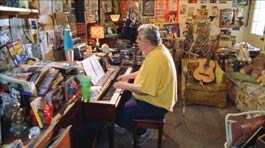home | metro silicon valley index | movies | current reviews | film review

Seriously DIY: Daniel Johnston works out a number in his home studio.
Holy Ghost
'The Devil and Daniel Johnston' proves that rock, acid and the Church of Christ make a potent mix
By Richard von Busack
ANOTHER WAY to define "genius" is as a person you would be wary about giving a room in your house. Daniel Johnston, the subject of The Devil and Daniel Johnston, is exactly that kind of genius. Johnston's heyday as a minor celebrity came in the early 1990s, thanks to the power of a Johnston T-shirt that Kurt Cobain loved and wore everywhere. Raised in West Virginia, Johnston is a folk artist whose Pentecostal agonies and ecstasies were unusual even by the Bible Belt's generous standards. He drifted into Austin, Texas, completely by accident (he was a stranded carnie). There, Johnston accosted Louis Black, editor of the Austin Chronicle, who was dazzled by Johnston's homemade musical cassettes. When MTV brought its Cutting Edge show cameras to schmooze Austin's music scene, Johnston horned his way into the shot, and his local fame grew.
Unfortunately, LSD and a Church of Christ background don't mix. We see a clip of a Butthole Surfers concert, like the one Johnston attended with a head stuffed with psychedelics. The stage show ("blood"-smeared topless dancers, roaring psychedelic gibberish--or, if you will, Gibbyrish) delivers everything the preacher warned you about. Johnston became bedeviled, delusional, haunted by the Beatles' sinister "Revolution No 9." The already unbalanced young man went off into a decade-long tour of mental hospitals, earning one session for trying to crash his family's plane. In this loving yet never deluded account, we see Johnston in his childhood. From the evidence of now mold-defaced Super 8 films, he was a kid loaded with talent and adept as a cartoonist. His parents were baffled. It is like that Ian McKellen speech in Gods and Monsters about the plight of a farmer given a giraffe: All he would know what to do with it is hitch it to a plough. Later, at one small-scale art school in east Ohio, Johnston fell in love with a woman who barely knew him, and he turned the obsession into a lifelong artistic passion.
Johnston's plaintive love songs have been recorded by almost a dozen musicians. My favorite, Johnston's merry yet fatal "Casper the Friendly Ghost," ends the film in a sequence shot at a live concert. Here, as elsewhere in his music, Johnston gives the sense of a person who sees his life in the past tense. As he put it, "It was my fate to become famous, but also to become a damned soul." If there's something holy in Johnston's pain, there's even more evidence of the power of agape in the people around him. Kathy McCarthy of the band Glass Eye, hanging out in her comfy '50s kitchen, describes the way Johnston turned his vast need for love on her. She returned his affection, in a sense, by recording an album of his songs titled Dead Dog's Eyeball. Jeff Tartakov still sells copies of the lo-fi tapes that made Johnston famous on his Stress Records website. Most saintly of all are Bill and Mabel Johnston, who still live with their son. Feuerzeig's labor-of-love documentary restages the odyssey of the ill and painfully sensitive musician. This means picking up the scattered traces of a wanderer and sometimes creatively restaging his life. (It's done whimsically, especially in one POV scene of Johnston being punched out.) On one level, this heartbreaking and compassionate documentary is pretty much the best movie about Austin since Slacker. On another, it's an essential movie about charisma and madness and how they go together.
![]() The Devil and Daniel Johnston (PG-13; 110 min.), a film by Jeff Feuerzeig, opens Friday, April 7 at selected theaters.
The Devil and Daniel Johnston (PG-13; 110 min.), a film by Jeff Feuerzeig, opens Friday, April 7 at selected theaters.
Send a letter to the editor about this story.
|
|
|
|
|
|